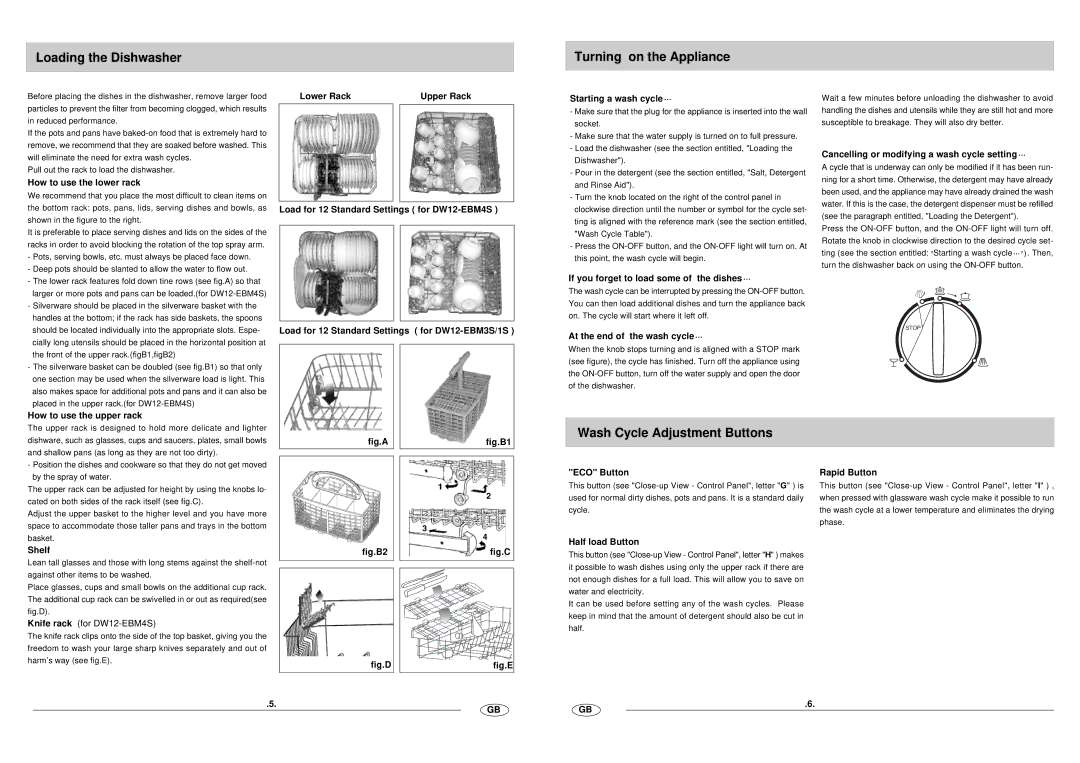
Loading the Dishwasher
Before placing the dishes in the dishwasher, remove larger food | Lower Rack |
| Upper Rack |
particles to prevent the filter from becoming clogged, which results |
|
|
|
in reduced performance. |
|
|
|
If the pots and pans have |
|
|
|
remove, we recommend that they are soaked before washed. This |
|
|
|
will eliminate the need for extra wash cycles. |
|
|
|
Pull out the rack to load the dishwasher. |
|
|
|
How to use the lower rack
Turning on the Appliance
Starting a wash cycle
- Make sure that the plug for the appliance is inserted into the wall |
socket. |
- Make sure that the water supply is turned on to full pressure. |
- Load the dishwasher (see the section entitled, "Loading the |
Dishwasher"). |
- Pour in the detergent (see the section entitled, "Salt, Detergent |
and Rinse Aid"). |
Wait a few minutes before unloading the dishwasher to avoid handling the dishes and utensils while they are still hot and more susceptible to breakage. They will also dry better.
Cancelling or modifying a wash cycle setting
A cycle that is underway can only be modified if it has been run- ning for a short time. Otherwise, the detergent may have already been used, and the appliance may have already drained the wash
We recommend that you place the most difficult to clean items on the bottom rack: pots, pans, lids, serving dishes and bowls, as shown in the figure to the right.
It is preferable to place serving dishes and lids on the sides of the racks in order to avoid blocking the rotation of the top spray arm.
-Pots, serving bowls, etc. must always be placed face down.
-Deep pots should be slanted to allow the water to flow out.
-The lower rack features fold down tine rows (see fig.A) so that larger or more pots and pans can be loaded.(for
-Silverware should be placed in the silverware basket with the handles at the bottom; if the rack has side baskets, the spoons should be located individually into the appropriate slots. Espe- cially long utensils should be placed in the horizontal position at the front of the upper rack.(figB1,figB2)
-The silverware basket can be doubled (see fig.B1) so that only one section may be used when the silverware load is light. This
also makes space for additional pots and pans and it can also be placed in the upper rack.(for
How to use the upper rack
Load for 12 Standard Settings ( for
Load for 12 Standard Settings ( for
- Turn the knob located on the right of the control panel in |
clockwise direction until the number or symbol for the cycle set- |
ting is aligned with the reference mark (see the section entitled, |
"Wash Cycle Table"). |
- Press the |
this point, the wash cycle will begin. |
If you forget to load some of the dishes
The wash cycle can be interrupted by pressing the
At the end of the wash cycle
When the knob stops turning and is aligned with a STOP mark (see figure), the cycle has finished. Turn off the appliance using the
water. If this is the case, the detergent dispenser must be refilled (see the paragraph entitled, "Loading the Detergent").
Press the ![]() Starting a wash cycle
Starting a wash cycle![]()
![]() . Then, turn the dishwasher back on using the
. Then, turn the dishwasher back on using the
STOP
The upper rack is designed to hold more delicate and lighter dishware, such as glasses, cups and saucers, plates, small bowls and shallow pans (as long as they are not too dirty).
fig.A | fig.B1 |
Wash Cycle Adjustment Buttons
-Position the dishes and cookware so that they do not get moved by the spray of water.
The upper rack can be adjusted for height by using the knobs lo- cated on both sides of the rack itself (see fig.C).
Adjust the upper basket to the higher level and you have more space to accommodate those taller pans and trays in the bottom basket.
Shelf
Lean tall glasses and those with long stems against the
Place glasses, cups and small bowls on the additional cup rack. The additional cup rack can be swivelled in or out as required(see fig.D).
Knife rack (for DW12-EBM4S)
The knife rack clips onto the side of the top basket, giving you the freedom to wash your large sharp knives separately and out of harm’s way (see fig.E).
| 1 |
| 2 |
| 3 |
| 4 |
fig.B2 | fig.C |
fig.D | fig.E |
"ECO" Button
This button (see
Half load Button
This button (see
It can be used before setting any of the wash cycles. Please keep in mind that the amount of detergent should also be cut in half.
Rapid Button
This button (see
.5.
GB |
GB
.6.
